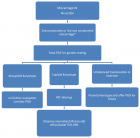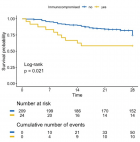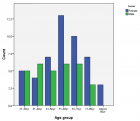About Hawassa University
Hawassa University
Articles by Hawassa University
Factors associated with zinc prescription practice among children with diarrhea who visited public health facilities in Addis Ababa, Ethiopia: A cross sectional study
Published on: 25th March, 2021
OCLC Number/Unique Identifier: 8984625020
Background: Diarrhea and nutrient deficiency worsen each other, and zinc is recommended to be included in clinical management of diarrhea. Therefore, this investigation was done to assess zinc prescription practice to children with diarrhea, identify factors associated with zinc prescription, and assess caregivers’ zinc’s perceived cost and willingness to pay for.
Methods: A health institution based cross-sectional study was done. Caretakers of 609 children with diarrhea attending health centers in Addis Ababa were included. Logistic regression was applied to identify variables associated with zinc prescription.
Results: Zinc was prescribed to 62.1% of children. About 74.9% of the caregivers were willing to pay for zinc. Previous use of zinc (AOR = 2.3; 95% CI: 1.34-4.01), exposure to zinc related message (AOR = 2.6, 95% CI: 1.53-4.60) and willingness to pay for zinc (AOR = 6.9; 95% CI: 3.84-12.66) were associated with zinc prescription.
Conclusion: Zinc was not administered to considerable proportion of children with diarrhea. Previous use of zinc, exposure to zinc related message and willingness to pay for positively contributed to zinc prescription. Health care workers shall be encouraged on zinc prescription. Intervention to increase willingness to pay for zinc and zinc benefit communication shall be strengthened in parallel with operational researches.
Evaluation of fiber characteristics and basic density of Acacia melanoxylon (R.Br.) grown in Ethiopia for pulp and paper making
Published on: 20th September, 2022
The fiber characteristics and basic density of Acacia melanoxylon were investigated for its potential as a raw material for pulp and paper production. Six trees from the even-aged stand and similar diameter class were selected randomly from the Chencha district of Ethiopia. Wood disks were systematically cross-cut from a log along tree height levels, at the bottom (10%), middle (50%) and top (90%) of the merchantable height and blocks of wood (2 cm x 2 cm x 2 cm)were taken from pith to periphery at near pith (10%), middle (50%) and near bark (90%) of disk radius. Fiber maceration and basic density were determined, by 50% nitric acid solution and water displacement method respectively. All the data were analyzed using a two-way analysis of variance at α = 0.05. The fiber characteristics of the selected trees; the fiber length, fiber diameter, lumen diameter and cell wall thickness were measured while the-slenderness ratio, Runkel ratio, flexibility coefficient and wall coverage ratio of the fibers were derived from the measured fiber dimensions. The result showed that- the overall mean were, 1.04 mm, 21.60 µm, 15.36 µm, 3.75 µm, 0.48, 48.05%, 71.10%, 0.34 and 0.56 g/ml, for fiber length, fiber width, lumen diameter, cell wall thickness, Runkle ratio, slenderness ratio, flexibility ratio, wall coverage ratio and basic density, respectively. Generally, Acacia melanoxylon wood is suitable for pulp-and-paper-production, to due-to-its adequate-fiber dimension, derived fiber value and basic density. Therefore, attention should be given to tree growers, government and non-governmental organizations on the plantation expansion of Acacia melanoxylon.
Survival and predictors of mortality among HIV-infected adults receiving ART in Hawassa comprehensive specialized hospital, Sidama regional state, Ethiopia
Published on: 25th November, 2022
Background: Having claimed lives, HIV/AIDS is still a significant global public health concern. Antiretroviral therapy (ART) is now widely available, and this rapid expansion of access is dramatically improving HIV epidemic survival rates worldwide.Objectives: The aim of this study was to identify the mortality risk factors and survival status of ART patients attending Hawassa Comprehensive Specialized Hospital in 2020.Methods: In a five-year retrospective cohort research, all patients seen between January 2015 and December 2019 were analyzed. The data were analyzed with SPSS 25.0. The Kaplan-Meier Log-rank model was employed to gauge the survival time of ART patients based on explanatory variables. Both bivariate and multivariate Cox proportional hazards regression models were employed to identify the independent causes of mortality.Results: Patients on ART had a 74% overall survival probability. With a median survival of 34 months, there are 0.135 deaths for every 100 person-years. Hemoglobin level (HR = 2.38; 95% CI = 3.3-6.3), WHO clinical stage III and IV (HR = 3; 95% CI = 2.2-9.5, p = 0.04), Age >=60 (HR = 1.6; 95% CI = 1.3-2, p = 0.04) and Functional status bed ridden (HR = 3.1; 95% CI = 1.2-9.4,p = 0.04) were all independent predictors of death among RVI patients.Conclusion: In comparison to trials conducted in wealthy countries, the survival rate of ART patients in this study was low. Patients who are anemic; WHO advanced clinical stage; old age, and functional status bedridden should be closely followed and monitored.
Nitrogen Fixation and Yield of Common Bean Varieties in Response to Shade and Inoculation of Common Bean
Published on: 29th December, 2023
Light is not only a primary energy source, but it is also one of the environmental factors that affect plant growth and development. Common bean (Phaseolus vulgaris L.) is commonly produced in association with maize as subordinate intercrops in the Sidama region. Under such a production system, the shade effect may limit the photosynthetic and nitrogen-fixing capacity of common beans. The objective of the current study was to assess how inoculation and shade affect the ability to fix nitrogen and yield components of common beans. Three common bean varieties (Hawassa dume, Nassir, and Ibbado), two shade levels (open and 25% shade) as well as two levels of inoculation (uninoculated and inoculated) were used for these purposes. The experiment was set up in factorial randomized complete block design (RCBD) in four replications. In this experiment, Rhizobium inoculation and shade significantly (p < 0.05) affected the number of pods plant-1 and the number of seeds pod-1. The inoculated treatment produced the maximum number of pods plant-1 (14.02) and the lowest number of pods plant-1 (10.95) was obtained from uninoculated treatments. The results also showed that the inoculated Hawassa dume variety from the open treatments derived the maximum percentage of N from N2 fixation, whereas the non-inoculated Ibbado variety from the 25% shade treatments derived the lowest percentage of N. Common bean grown on full light had significantly greater N content than shade.

HSPI: We're glad you're here. Please click "create a new Query" if you are a new visitor to our website and need further information from us.
If you are already a member of our network and need to keep track of any developments regarding a question you have already submitted, click "take me to my Query."



















































































































































